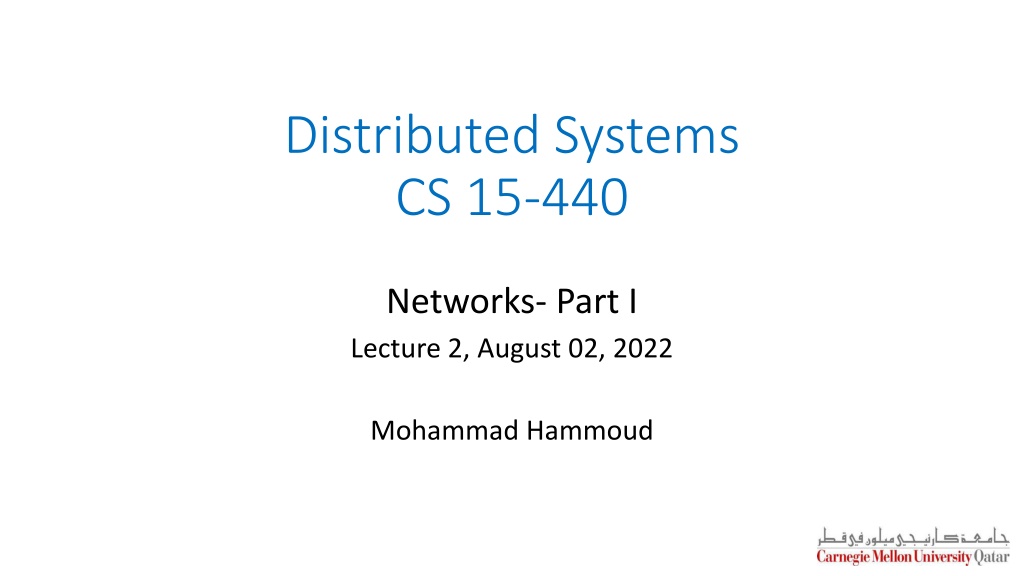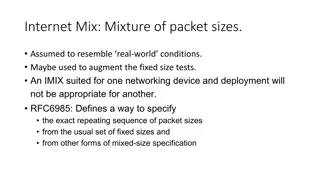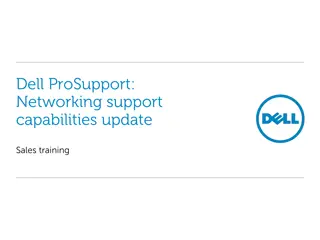
Understanding Networks in Distributed Systems
Explore the fundamentals of networks in distributed systems, covering topics like network types, networking principles, latency, bandwidth, and considerations for performance, scalability, reliability, and security. Gain insights into the impact of networking issues on distributed systems' functionality and learn how to optimize designs for efficient communication and resource management.
Uploaded on | 0 Views
Download Presentation

Please find below an Image/Link to download the presentation.
The content on the website is provided AS IS for your information and personal use only. It may not be sold, licensed, or shared on other websites without obtaining consent from the author. If you encounter any issues during the download, it is possible that the publisher has removed the file from their server.
You are allowed to download the files provided on this website for personal or commercial use, subject to the condition that they are used lawfully. All files are the property of their respective owners.
The content on the website is provided AS IS for your information and personal use only. It may not be sold, licensed, or shared on other websites without obtaining consent from the author.
E N D
Presentation Transcript
Distributed Systems CS 15-440 Networks- Part I Lecture 2, August 02, 2022 Mohammad Hammoud
Today Last Session: Introduction Today s Session: Network Types Networking Principles: Layering and Encapsulation Announcements: PS1 will be released on Thursday. It is due on August 14 On Thursday s recitation, we will practice on Java programming (Projects I and II will be in Java)
Introduction to Networks Learning Outcomes After two lectures on networks, you will be able to: Identify different types of networks Describe various networking principles such as layering, encapsulation, and packet-switching, among others Examine how packets are routed Realize how congestion is controlled Analyze the performance, scalability, and reliability of networks
Networks in Distributed Systems A distributed system is a collection of components that communicate to solve a problem Why should designers of distributed systems know about networks? Networking issues severely affect performance, fault-tolerance, and security of distributed systems E.g., Gmail outage on Sep 1, 2010 Google Spokesman said we had slightly underestimated the load which some recent changes placed on the request routers. . few of the request routers became overloaded causing a few more of them to also become overloaded, and within minutes nearly all of the request routers were overloaded.
A Primer: Latency and Bandwidth Case 2 B Case 1 B L L Case 3 B L B = Bandwidth (or Capacity) and L = Latency (or Delay) B L gives approximately the number of bits in flight As B L increases, uncertainty increases (more bits might get lost) High value of B L leads to Buffer Bloat
Networks in Distributed Systems Networking Issue Comments on a Distributed System Design Affects choices of whether to optimize for network or other resources Performance Size of Internet is increasing; expect greater traffic and latency in future Scalability Detect communication errors and perform error-checks at the application layer (end-to-end argument!) Reliability Install firewalls at gateways; deploy end-to-end authentication; employ encryption, etc., Security Expect intermittent connection for mobile devices Mobility Internet is best-effort. It is hard to ensure strict QoS guarantees for, say, multimedia data Quality-of-service
Network Classification Important ways to classify networks 1. Based on size Body Area Networks (BAN) Personal Area Networks (PAN) Local Area Networks (LAN) Wide Area Networks (WAN) 2. Based on technology Ethernet Networks Wireless Networks Cellular Networks
Network Classification BANs and PANs Body Area Networks (BAN): Devices form wearable computing units Several Body Sensor Units (BSUs) communicate with Body Central Unit (BCU) Typically, low-cost and low-energy networking Personal Area Networks (PAN): PAN connects various digital devices carried by a user (mobile phones, tablets, cameras) Low-cost and low-energy networking e.g., Bluetooth
Network Classification LAN Computers connected by single communication medium e.g., Twisted copper wire, optical fiber High data-transfer-rate and low latency LAN consists of Segment Usually within a department/floor of a building Shared bandwidth, no routing necessary Local Networks Serves campus/office building Many segments connected by a switch/hub Typically, represents a network within an organization
Network Classification WAN Generally, covers a wider area (cities, countries,...) Consists of networks of different organizations Traffic is routed from one organization to another Routers Bandwidth and latency Vary Worse than a LAN Largest WAN = Internet
Brief Summary of Important Networks (Based on Size) A Segment A Point-to-point link A network of networks A Network Wide Area Network (WAN)
Types of Networks Based on Technology Ethernet Networks Predominantly used in the wired Internet Wireless LANs Primarily designed to provide wireless access to the Internet Low-range (100s of m), high-bandwidth Cellular networks (2G/3G/4G/5G) Initially, designed to carry voice Large range (few kms) Low-bandwidth
Typical Performance for Different Types of Networks Network Example Range Bandwidth (Mbps) Latency (ms) Wired LAN Ethernet 1-2 km 10 10,000 1 10 Wired WAN Internet Worldwide 0.5 600 100 500 Wireless PAN Bluetooth 10 30 m 0.5 2 5 20 Wireless LAN WiFi 0.15 1.5 km 11 108 5 20 Cellular 2G GSM 100m 20 km 0.270 1.5 5 Cellular 3G 1 5 km 348 14.4 100 500 Cellular 4G 16 km 10- 100 36-48 Modern Cellular 5G 2 km 50- 1000 10-30
Latency and Bandwidth Case 2 (WiFi) Case 1 B B (Ethernet) L L Case 3 (WAN) B L B = Bandwidth (or Capacity) and L = Latency (or Delay) B L gives approximately the number of bits in flight As B L increases, uncertainty increases (more bits might get lost) High value of B L leads to Buffer Bloat
Networking Principles Network Protocols Packet Transmission Network Layers Physical layer Data-link layer Network layer and routing Transport layer and congestion control
Networking Protocols If two entities want to communicate on a network, pre-defined agreements are necessary How a message will be formatted? How does the receiver know the last bit in the message? How can a receiver detect if the message is damaged? Protocol is a well-known set of rules and formats to be used for communication between the entities Standardizing a well-known set of protocols supports communication among heterogeneous entities
Packet Transmission Messages are broken up into packets A packet is the unit of data that is transmitted between an origin and a destination Packets can be of arbitrary lengths Maximum size of the packet is known as Maximum Transmission Unit (MTU) MTU prevents one host from sending a very long message Each packet has two main fields Header: Contains meta-information about the packet e.g., Length of the packet, receiver ID Data Header Data
Network Layers Network software is arranged into a hierarchy of layers Protocols in one layer perform one specific functionality Layering is a scalable & modular design for complex software Typical functionalities in a network software: 011100011 0011 011 Src Functionality Layer Dest Transmits bits over a transmission medium Physical Coordinates transmissions from multiple hosts that are directly connected over a common medium Data link Destination machine Network Routes the packets through intermediate networks P1 P2 P3 Handles messages rather than packets between sender and receiver processes Transport Satisfies communication requirements for specific applications Application
OSI Reference Model Open Systems Interconnection (OSI) Reference Model A layered networking model standardized by ISO The model identifies various layers and their functionalities Functionality Layer Example Protocols Satisfy communication requirements for specific applications Application HTTP, FTP Transmit data in network representation that is independent of representation in individual computers Presentation CORBA data representation Support reliability and adaptation, such as failure detection and automatic recovery Session SIP Handle messages rather than packets between sender and receiver processes Transport TCP, UDP Route the packet through intermediate networks Network IP, ATM Coordinate transmissions from multiple hosts that are directly connected over a common medium Data-link Ethernet MAC Transmit bits over a transmission medium Physical Ethernet
Packet Encapsulation Encapsulation is a technique to pack and unpack data packets in a layered architecture
Layers that We Will Study Today 1. Physical layer 2. Data-link layer 3. Network layer
Layers that We Will Study Today 1. Physical layer 2. Data-link layer 3. Network layer
Physical Layer Physical layer protocols transmit a sequence of bits over a transmission medium Modulate the bits into signals that can be transmitted over the medium Type of signal transmitted Data-link layer protocol Transmission Medium Bits Twisted-pair (Ethernet cable) Electrical signal A physical layer protocol Signal Fiber Optic Circuits Light signal Transmission Medium Wireless channel Electro-magnetic signal
Layers that We Will Study Today 1. Physical layer 2. Data-link layer 3. Network layer
Data-link Layer Protocols in data-link layer ensure that the packets are delivered from one host to another within a local network Data-link layer protocols provide two main functionalities: How to coordinate between the transmitters such that packets are successfully received? Coordination How to identify another host on the local network? Addressing over local networks
Coordination at Data-link Layer A packet is not received successfully at the receiver if a sender transmits the data when another sender s transmission is active The packet is said to have experienced collision if it is not successfully received at the receiver Collision is avoided by sensing the medium before transmission
Addressing over Local Networks Each device that is connected to a network has a unique address called Medium Access Control (MAC) address MAC addresses are six bytes long e.g., 2A:D4:AB:FD:EF:8D Approach: Data-link layer broadcasts the packet over the medium Receiver reads the packet header and checks if the packet is addressed to it
Layers that We Will Study Today 1. Physical layer 2. Data-link layer 3. Network layer
Network Layer Network layer protocols perform the role of routing They ensure that a packet is routed from the source machine to the destination machine Packets may traverse different LANs to reach the destination Source Router Internet Protocol (IP) is a widely-used network layer protocol IP addresses are typically used to identify machines Destination
Router A router is a device that forwards the packets between multiple networks Routers are connected to two or more networks Each network interface is connected to a LAN or a host Packet travels up until the network layer on the router Source machine Router Dest machine A Router Application Application Transport Transport LAN-1 LAN-3 Int-1 Int-2 Int-3 Network Network Network Data-link Data-link Data-link LAN-2 Physical Physical Physical
Routing Algorithm Packets have to be transmitted in a series of hops through the routers The series of hops that a packet takes is known as a route Routing algorithm is responsible for determining the routes for the transmission of packets Challenges for designing routing algorithms in the Internet: Performance: The traffic across different networks vary Router failures: Routers in the Internet may fail R2 S D R1 R4 R4
Routing Algorithm (Contd) Routing algorithms have two activities 1. Determine the next-hop taken by each packet The algorithm should be fast and efficient 2. Dynamically update connectivity information Maintain the knowledge of the network by monitoring routers and traffic The above activities are distributed throughout the network Routing decisions are made on an hop-by-hop basis Information about possible next-hop routers is stored locally Information is updated periodically We will study in the next lecture a simple routing algorithm called Distance Vector Algorithm
Next class Networking- Part II






















